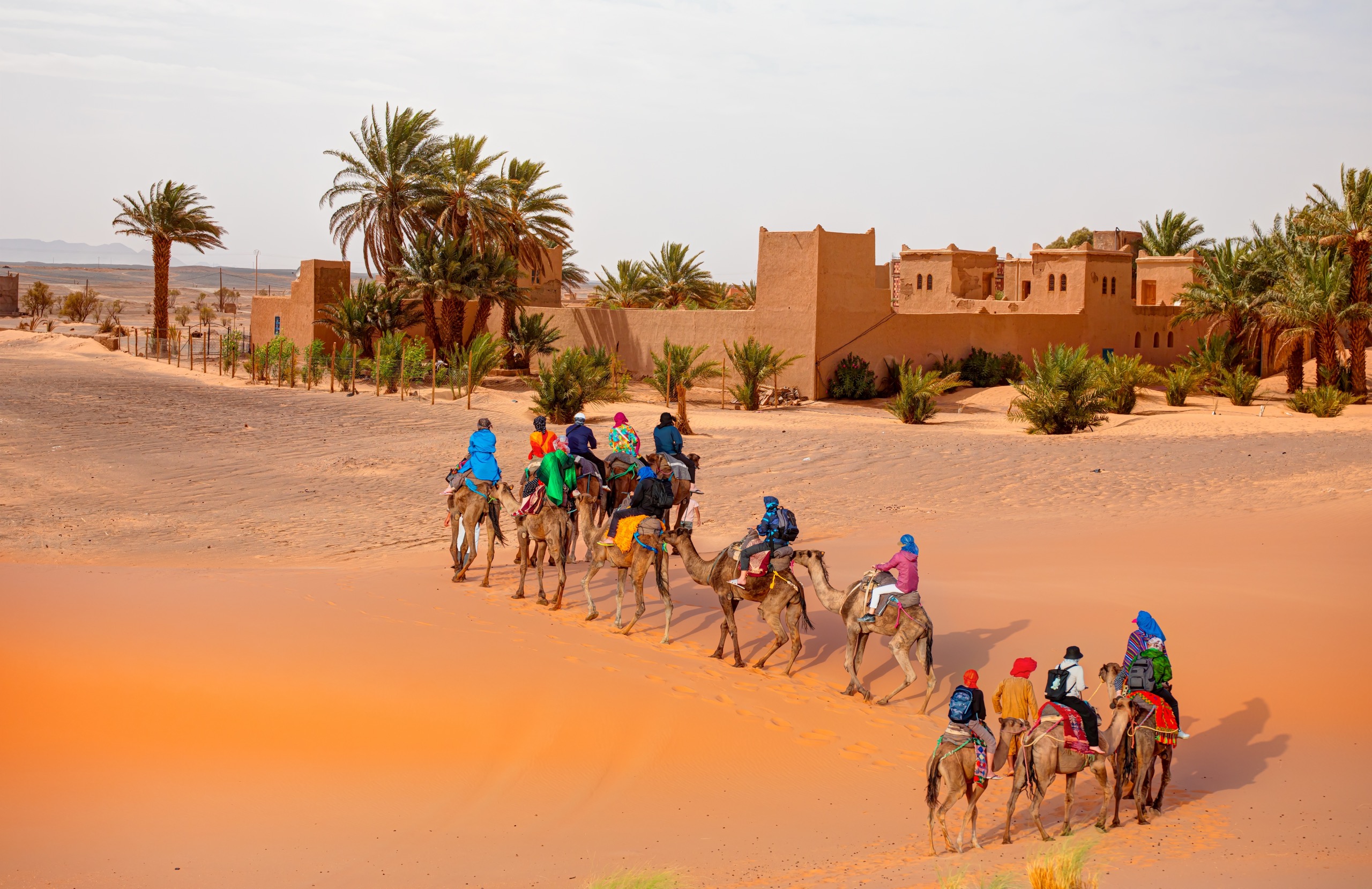Begin in Tangier and travel through the Rif Mountains to the blue charm of Chefchaouen.
Explore ancient Volubilis, the imperial cities of Meknes and Fes, and the rich culture of Morocco’s medinas.
Journey south through Middle Atlas forests to the Sahara Desert, where camel treks and Berber music await.
Pass dramatic landscapes like Toudgha Gorge, Aït Benhaddou, and the High Atlas Mountains.
End your trip in vibrant Marrakech and breezy Essaouira, blending coastal charm with historic splendor.
Welcome to Tangier the gateway between Europe and Africa! Located
close to the south of Spain, visit the old quarter, a café in the square
,visit the kasbah museum ,see the king palace and the caves of
Hercules, and take a drive along the scenic Corniche., then drive straight
to the blue city of Chefchaouen passing by the Rif Mountains. Enjoy the
scenic route, stopping along the way to hike to the Waterfalls of Akchour
. Chefchaoen offers endless winding narrow streets and picturesque
buildings. Stop in square Outa Hammam for a restaurant or café and
enjoy a meal as you people watch.
Though non-Muslims are not permitted to enter, the Grand Mosque is
still worth a visit. From there, explore the nearby kasbah (old fortification)
and tour the garden, museum, and some of the old prison cells. Follow a
path outside of the city walls to Hotel Atlas and climb to the rooftop to
enjoy a panoramic view of the Blue City. For the slightly more athletic,
follow the street east to pass over the Ras El Ma Spring and ascend the
path (20-30 minutes) until you reach the abandoned white Spanish
Mosque. Enjoy one last view over Chefchaouen as the sun sets behind
the mountains.
Ancient Roman ruins hold their charm in Volubilis.
Rise early to snap photos of the people-less streets before leaving for
Fes. Stop along the way at the UNESCO-protected Volubilis ruins the
Roman's farthest reach in Africa. Wander the complex, exploring
merchant homes with still-intact heating systems, temples, and many
mosaics in situ. Continue to the smaller, less busy version of Fes,
Meknes, for an introduction to a historic imperial city. The two main
points of interest are the Imperial City and the medina. visit Bab Mansour
gate, the Mausoleum of Moulay Ismail, and the Royal Stables.
Continue on to Fes .over night in a old guest house (Riad).
Fes is the oldest of the imperial cities in Morocco (Meknes, Marrakech,
and Rabat are the others) and perhaps the most interesting to explore. A
UNESCO-protected site, the city hasn't undergone much colonial
development, leaving you to experience its medieval charm. Fes
consists of two old medina quarters, Fes El Bali (where you will spend
most of your time) and Fes El Jedid (a slightly newer part of the city),
and the early 20th-century French designed Ville Nouvelle. Meet your
guide to help you navigate the narrow and maze-like ancient streets of
the medinas, starting in Fes El Bali (789 CE).
Note the Spanish and Tunisian influenced architecture as you pass the
variety of souks (markets) offering spices, leather goods, and pewter.
Known for its tanneries and the acrid smell associated with them, visit
the popular Chouara Tannery and climb to the roof of a nearby shop for
a better view of the goings-on. Visit the 14th-century Al Attarine Madrasa
and admire the Zellij tilework before checking out one of the oldest, still
operating universities in the world, Al-Karaouine University (859 CE).
Find the Mellah (old Jewish quarter) in Fes El Jedid for another
encompassing view of the city.
A camel caravan treks through the Moroccan Sahara
Continue your journey south, over the Col du Zad pass (7,165 feet or
2,184m) and through the cedar forests of the Middle Atlas mountains.
You will see families of Barbary macaque monkeys in the trees and by
the side of the road as you head to Midelt (the "apple city") for lunch.
Appreciate the scenery ,the Moulouya River and the apple orchards.
Next, travel over the Tizi N'Talremt pass and into the Ziz Valley dotted
with oases and palm tree clusters. Notice the many ksars, fortified
houses merchants built to protect their wares (gold, salt, and spices).
Nearing Erfoud, you will start to see the early signs of the Sahara sand
dunes. Never stationary, the dunes travel as the winds shift. If you're
lucky, you may come across a nomadic Berber family and have the
chance to drink tea together. Visit Erfoud and discover how the fossil-
rich rock of its mines is transformed into decorative and practical objects.
Continue on to the extensive sea of sand dunes of Erg Chebbi. Covering
13.5 square miles (35 square km), some dunes rise to over 656.2 feet
(200 m), their color changing with the moving sun.
Outside of Merzouga, change the pace and prepare for a camel ride
through the dunes, arriving at camp just before sunset. Climb up the
nearest sand dune to watch the colorful display as the sun sets behind
the colossal dunes. Return to camp for dinner in the open air and an
evening by the campfire enjoying traditional Berber music from the locals
under a blanket of stars. Spend the night in a Bedouin-style tent.
Wake early to catch a desert sunrise, before trying your skill at
sandboarding. You will also have the option of joining either an Erg
Chebbi (sand dune) tour or an ATV tour. Visit nearby Khemliya, a
traditional Saharan village, and experience traditional drumming music
and dancing before taking a short walk around the village. Leave the
dunes behind and stop in the market town of Rissani, entering through
its impressive gate. Known for its livestock auction it's worth your time
finding the 'donkey parking lot' to delight your senses.
Continue on to Tinghir . This desert town offers awesome views of
neighboring towns hugging the length of the extensive river oasis (30
miles or 48 km of palm trees). Stop at today's final destination, the
Toudgha Gorge. 984 feet (300 m) high and carved by the Toudgha River
through red limestone, here you can enjoy a leisurely walk in and around
the gorge and relax in the cool waters of the shallow river below.
Travel along the Valley of a Thousand Kasbahs to Morocco's most
famous kasbah, Aït Benhaddou. Pass through the Dades Valley and
Boumalne Dades. Stop in Kelâat M'Gouna to admire the rose bushes
bordering plots of farmland. Visit a rose collective to see the process of
converting rose petals into rose water and oil. Continue west to stop in
Ouarzazate and discover how its nearby regions have been featured in
movies, including Lawrence of Arabia, Gladiator, and Black Hawk Down.
Join a movie studio tour and visit the Museum of Cinema to learn more
about the film making process and history of the area.
Travel to nearby Aït Benhaddou. A UNESCO World Heritage site, the old
ksar dates from the 11th century when it held an important position along
the trans-Saharan trade route. Settle into your accommodation in the old
town, before wandering the near-empty alleys and passageways in the
late afternoon. Climb up to an excellent vantage point to see the kasbah
and surrounding area. Game of Thrones fans may want to trek down to
the river to see the gates featured in the popular HBO series. Long after
the day crowds have left, enjoy a quiet dinner overlooking the valley.
Leave Aït Benhaddou behind to begin the ascent over the High Atlas
mountains. Spot Mount Toubkal, the mountain range's highest peak, at
13,671 feet (4,167 m). Near the top, stretch your legs for a great
panoramic view of the mountains. Stop in Taddart to visit an Argan Oil
Cooperative and learn, as well as sample, how olives are processed for
various uses. As you descend the High Atlas, you will notice a dramatic
change in the climate and landscape. Soon you will be a part of the
noise and clamor of Marrakech.
After a long day on the road, settle into your hotel and spend the rest of
the afternoon as you like. In the early evening, the main square and
busiest square in all of Africa! Jamaa El-Fena, comes alive with
musicians, performers, snake charmers, games, and food stalls, a catch-
all of entertainment! If you want to enjoy the spectacle from a distance,
choose one of the many cafés surrounding the square and enjoy a cup
of mint tea and a meal.
The "Red City" for its 1000-year-old red sandstone city walls and
buildings, Marrakech has always been a thriving city dating back to the
Berber Empire (1062 ACE). Meet your guide for a half-day tour, starting
with browsing the stalls of Souk el Attarin (spices), Souk Haddadine
(blacksmiths), and Souk Smata (slippers). Visit Souk the dyers' souk
,and visit the Koutoubia Mosque, along the way note the open spaces
that extend off of some alleys. These fondouks were once medieval inns
that provided travelers and merchants with shelter for themselves and
their animals.
The hard-to-miss Mosque's 253 feet (77 m) minaret is the tallest tower
built in Marrakech. Relax in the adjoining gardens, before carrying on to
Ben Youssef Madrasa. Built in the 16th century, this madrasa once
housed students of the nearby mosque. Admire the Moroccan
artisanship carved cedar, stucco plaster. Visit the Marrakech Museum of
Moroccan Arts for more examples of traditional art and woodwork. South
of Jamaa El-Fena is the Kasbah area with several worthwhile sights: the
Saadian Tombs, El Badi Palace, Bahia Palace, and the Jewish quarter
and cemetery.
Say goodbye to the Red City, and travel to Morocco's west coast
following a route that takes you over vast rolling plains. Along the way,
pass through an argan tree forest, endemic to this part of the world. You
may even see goats dining on the Argan fruit, up in the tree branches.
Visit an Argan cooperative to learn how argan oil is extracted from the
tree and what it's used for in the food and cosmetic industries.
Arrive in the port city of laid-back Essaouira, a nice contrast to frenetic
Marrakech, and spend the rest of the day as you choose. Walk the Skala
de la Kasbah (the 18th-century seafront ramparts) along the coast.
Designed by European engineers, old brass cannons line the walls and
offer viewing access over the Atlantic. Explore the UNESCO-protected
medina before making your way to the windswept beach. Jimi Hendrix
fans may want to take a short taxi ride to Diabat at the end of
Essaouira's beach where he reportedly spent some time. Walk back to
Essaouira and enjoy a meal of freshly caught seafood.
Your 10-Day Tour From Tangier comes to the end as we transfer you to
Marrakech or Casablanca Airport. Our team ensures you will arrive at
the airport 2 or 3 hours before your flight your Morocco travel agency
Epic Travel Morocco will always be at your side when ever you’ll decide
to join our Morocco North to South Explorer Tours.


